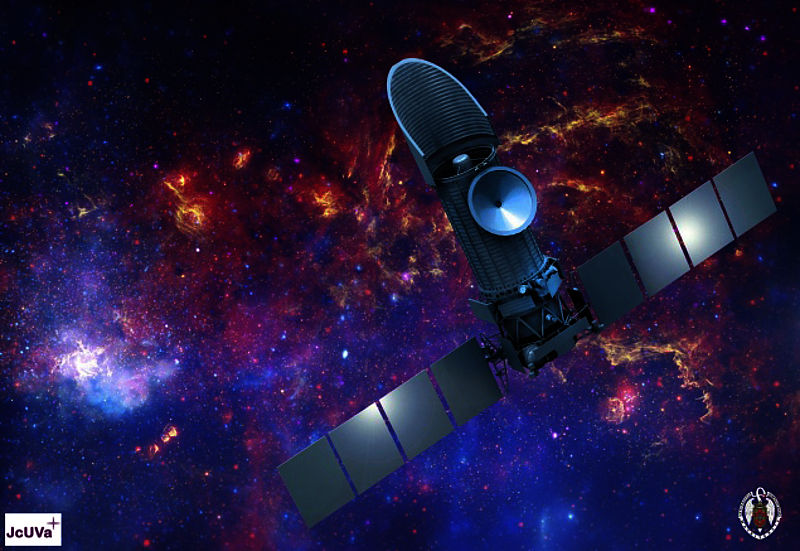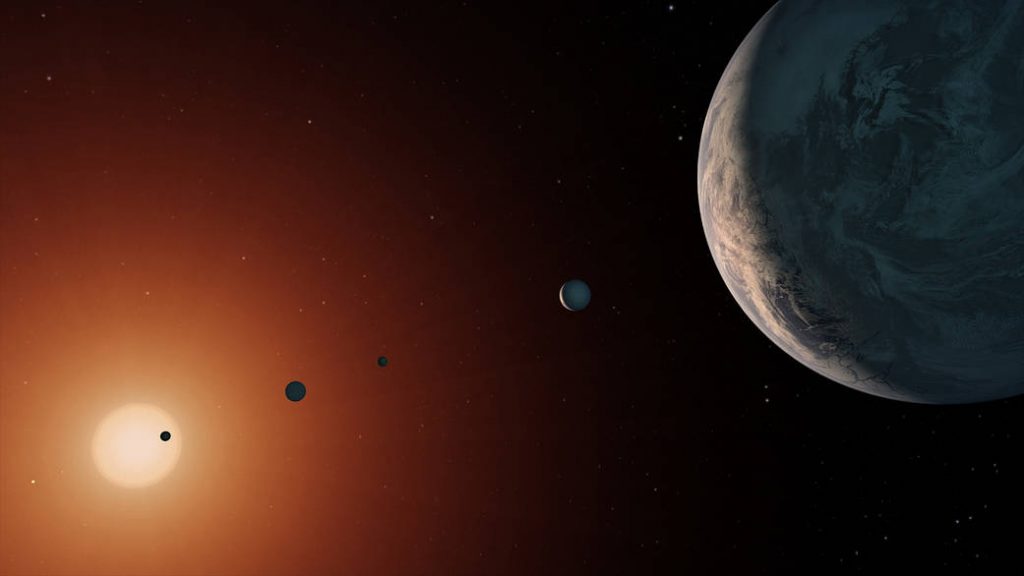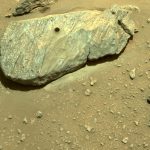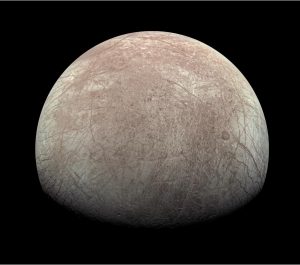
Hell and heaven: UVSPEX will test a technique for differentiating between Venus- and Earth-like exoplanets
A little over twenty extrasolar planets have now been discovered that orbit entirely within the habitable zone of their star with a size similar to that of the Earth(*). But does this mean these worlds are indeed similar to our home planet?
The “habitable zone” is the distance from the star where theoretical models predict that liquid water could be stable on the surface of the Earth orbiting at that location. The problem is, how do we know if the planets we find within the habitable zone are sufficiently like the Earth to be habitable in the same region?
For planets much larger than the Earth, we can make a reasonable guess that we would be out of luck. Planets with radii more than about 50% larger than the Earth typically have observed densities much lower than rock, suggesting they harbour thick atmospheres like the gas giants in our Solar System. These atmospheres create tremendous heat and pressure around any solid surface of the planet, making it difficult for liquid water to exist in or out of the habitable zone.

But what if we had a rocky planet in the habitable zone? Is it reasonable to assume its surface conditions could support water? Unfortunately, size alone is not a good enough to make a planet sufficiently Earth-like to be habitable within the habitable zone. In our Solar System, the Earth and Venus have a very similar size and mass. But Venus hosts a thick carbon dioxide rich atmosphere that swaddles the planet in heat to create surface temperatures high enough to melt lead. Put a Venus-like atmosphere around the Earth, and our planet would cook even in the habitable zone.
Exactly why the Earth and Venus evolved into such different worlds is unknown. Venus does not sit in our Sun’s habitable zone, and it is possible that the extra sunlight is responsible for its dastardly evolution. However, the exact boundaries of this region where the Earth could remain habitable are unclear.
The inner and outer edges of the habitable zone are usually defined by the ability of the Earth’s carbon cycle to adjust the levels of carbon dioxide in the atmosphere. Carbon dioxide is a greenhouse gas and higher quantities in the air trap heat more effectively around the planet, while lower abundances cool the Earth. Adjusting the level therefore allows for a range of orbits where the Earth can remain temperate and support surface liquid water.
But there are other effects aside from the carbon cycle that also contribute to controlling carbon dioxide levels. Our oceans are absorbers of carbon dioxide and their effect may widen the habitable zone and actually allow an Earth-like planet to remain habitable even on orbits around Venus. Other factors may therefore have been responsible for Venus’s fate, such as a different internal structure (hinted at by the lack of a planetary magnetic field) or the failure of Venus to develop plate tectonics. In this case, Venus could have formed in the Earth’s current location and still be uninhabitable. In short, it is not clear whether we should expect an Earth or Venus based on orbit.
But a new instrument being developed at JAXA could test an idea for sorting out Earth-like atmospheres from those similar to hot house Venus. The instrument is an ultraviolet spectrometer (117 – 144 nm), UVSPEX, which is due to fly onboard the Russian-led World Space Observatory UV, WSO-UV, with a planned launch in 2025.

Like many of the most prolific planet hunters such as the NASA Kepler Space Telescope, UVSPEX will look for planets transiting their host star. Transiting planets have an orbit that passes across the star’s surface as seen from the Earth. As the planet moves in front of the star, it obscures a small amount of the starlight, causing a periodic dip in the star’s brightness. In visible light, both a Venus-like and Earth-like planet would cause a similar attenuation. But in the ultraviolet, a very different effect can be seen.
While Venus’s carbon dioxide atmosphere traps heat close to the surface of the planet, the same gas acts as a coolant in the upper atmosphere. The outermost layer of the atmosphere—a region known as the exosphere—is only about 200 – 300 K (-73°C to 27°C) on the carbon dioxide laden Venus, but about 1000 K on the oxygen-rich Earth. The hotter temperatures cause the Earth’s exosphere to expand while Venus’s cool exosphere remains relatively small.

This is important because the gases in the exosphere absorb ultraviolet wavelengths. During a transit, ultraviolet light from the star will therefore be blocked by the planet’s solid body and up to its exosphere, creating a much larger drop in light for a planet with an Earth-like atmosphere compared to one of a similar size but harbouring a Venus-like cloak of gases. Planets around the small and dim red dwarf stars may see an even large effect, as these cooler stars emit extreme ultraviolet (EUV) several orders of magnitude greater than Sun-like stars. This would heat an oxygen-rich Earth-like atmosphere to temperatures as high as 10,000 K (9700°C), expanding it still further.
UVSPEX therefore has a relatively rapid way of differentiating between planets with Earth-like and Venus-like atmospheres around other stars. As the first instrument to try this technique, the best targets for UVSPEX will be small rocky worlds or those orbiting close to their star, where the difference in the transit dip is expected to be most apparent. If this is successful, future instruments could sweep through habitable zone Earth-sized planets, identifying those whose atmosphere most resembles our own.
As the Earth’s atmosphere blocks UV light, the study of transits in the UV must be done from space. Although the Hubble Space Telescope is also sensitive to the UV, the telescope’s orbit is within the Earth’s oxygen geocorona, which also partially blocks ultraviolet wavelengths. UVSPEX is therefore a pathfinder for a technique that could identify habitable worlds.

The results from such a study will be key to both identifying and understanding the formation of habitable worlds. One of the biggest questions in our own Solar System is why Earth and Venus evolved so differently. If it was due purely to sunlight, then UVSPEX and its successors should see a clear cut-off in orbital distance between planets with Earth-like atmospheres and those harbouring the toxic Venus gases. If this edge lies close to the predicted habitable zone boundary, then it will be the first test of the calculations that predict its edges.
Alternatively, UVSPEX may discover a mix of Venus- and Earth-like atmospheres, without a clear trend based on location. This would imply that the pair’s planetary evolution is driven by other effects. In which case, observations with instruments such as UVSPEX may be the fastest method to identify Earth-like worlds of interest for astrobiological studies. Planets with expanded oxygen atmospheres should be carbon dioxide poor, and the observation is sensitive to the abundance of carbon dioxide in the atmosphere. This makes the detection a potential probe for the presence of the carbon cycles that controls the levels of carbon dioxide in our own atmosphere, pointing to geologically active planets with potentially oceans and plate tectonics.
Such identification will be important for the next generation of both ground and space-based telescopes. These will be aimed at atmospheric characterisation of temperate planets, through analysing transmitted or reflected light at a wide range of wavelengths. These are incredibly time-consuming observations, which makes selecting the best candidates key to making the best use of available time on the instruments. UVSPEX will therefore be key to finding the Earth-like worlds around other stars and perhaps stepping close to a definitive answer to “are we alone?”
(*) For enquiring minds, this was defined as planets with either a radius less than 1.6 x Earth or a mass less than 6 x Earth. Current density statistics suggests this size of planet is likely to be rocky.
 Previous Post
Previous Post Next Post
Next Post






